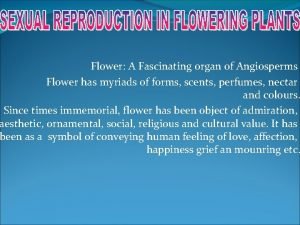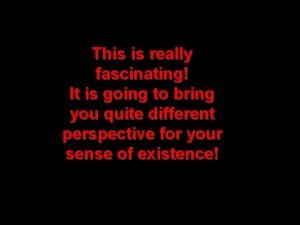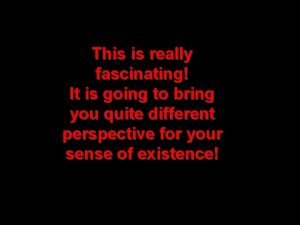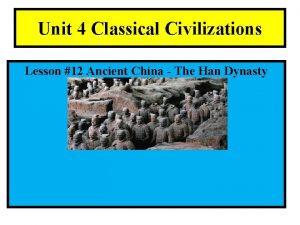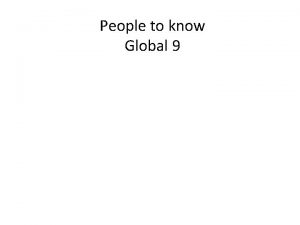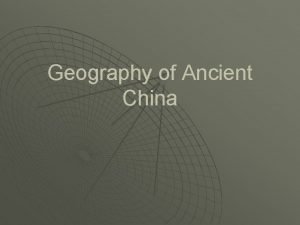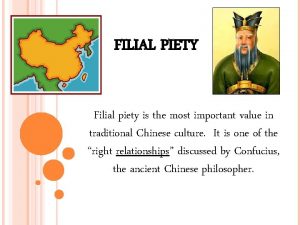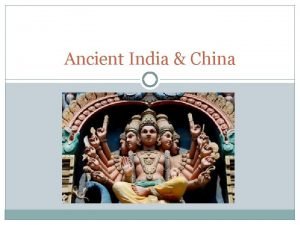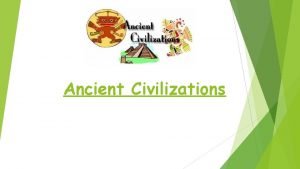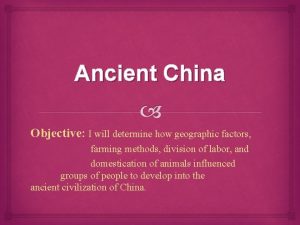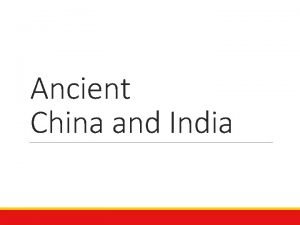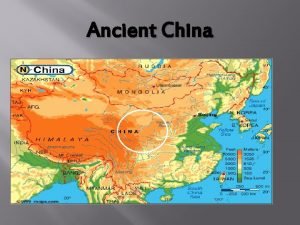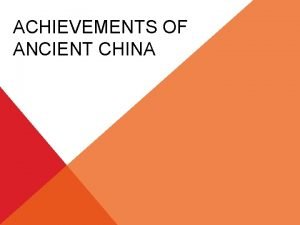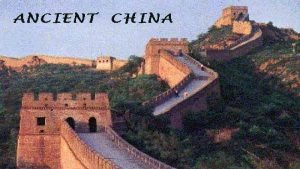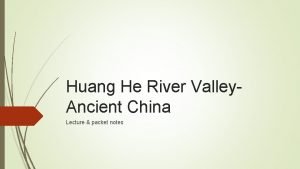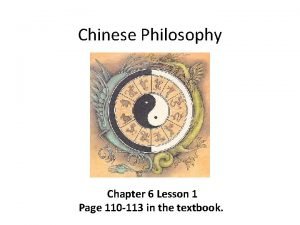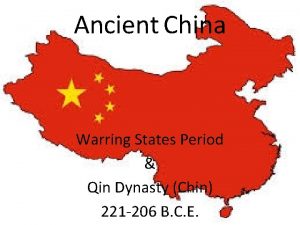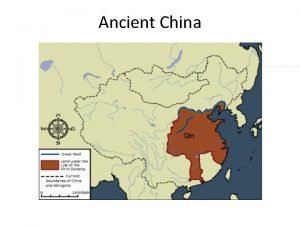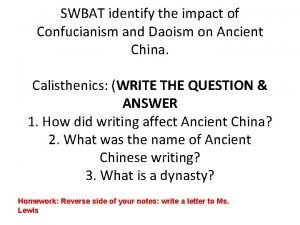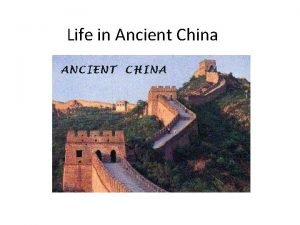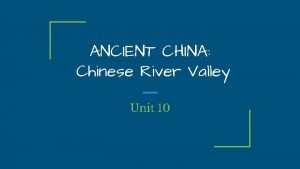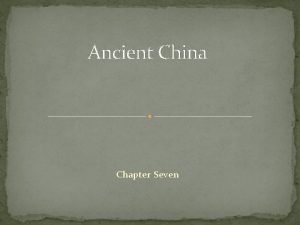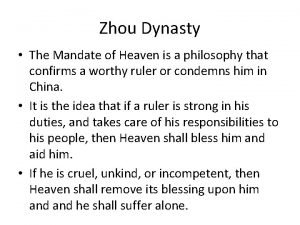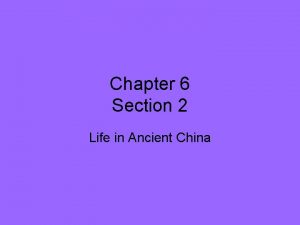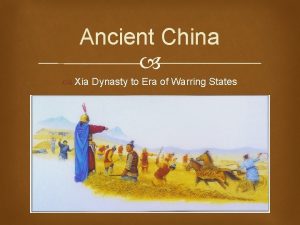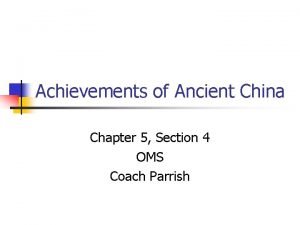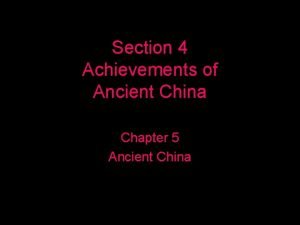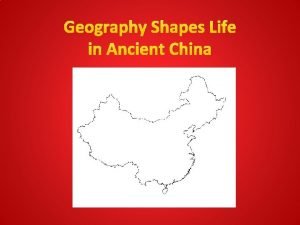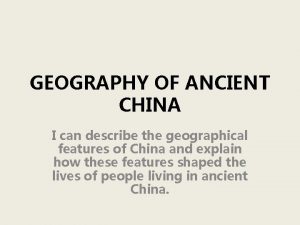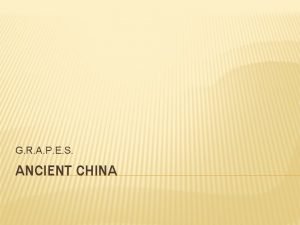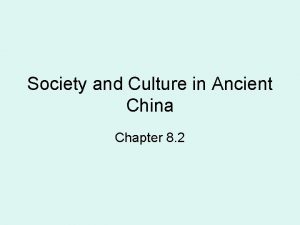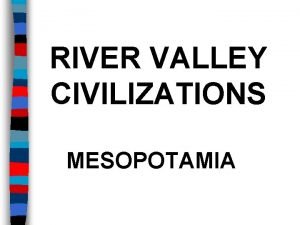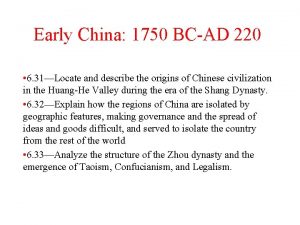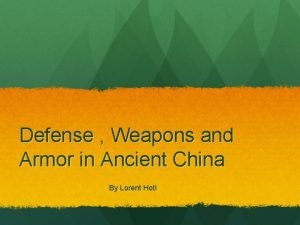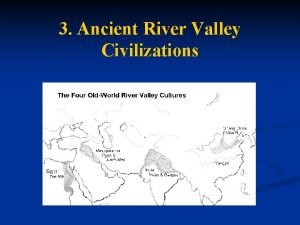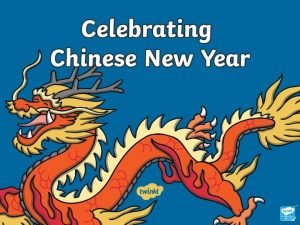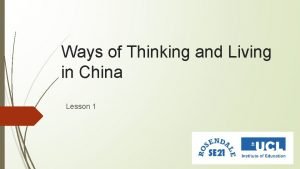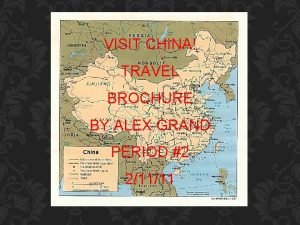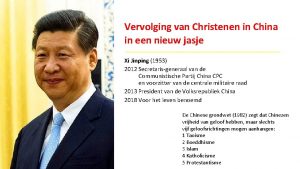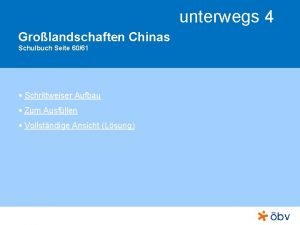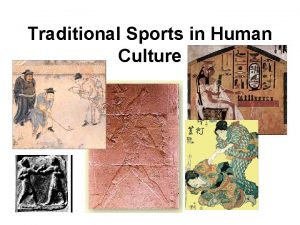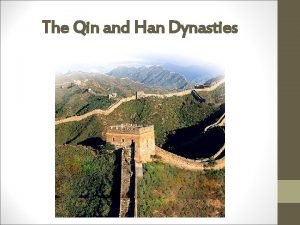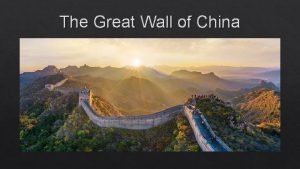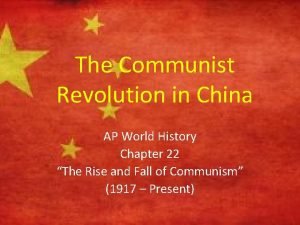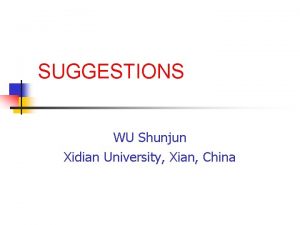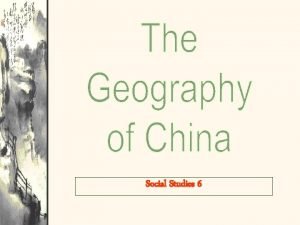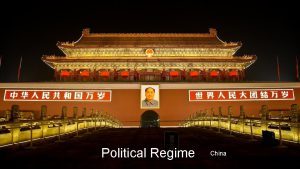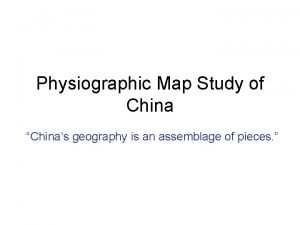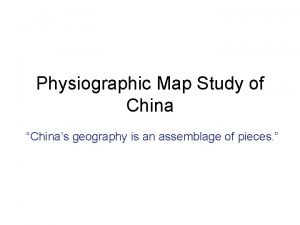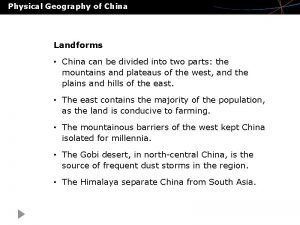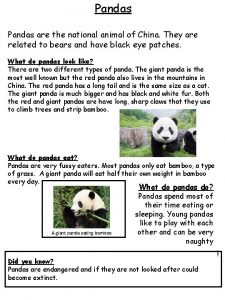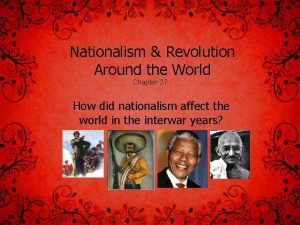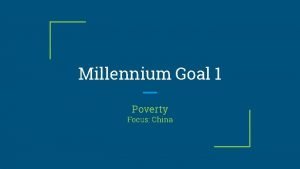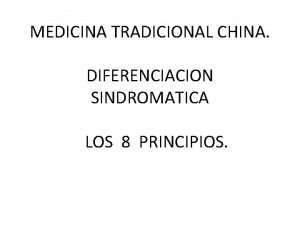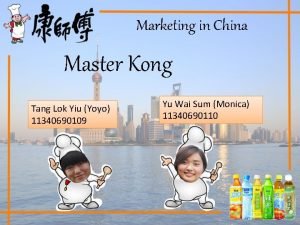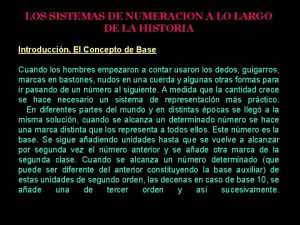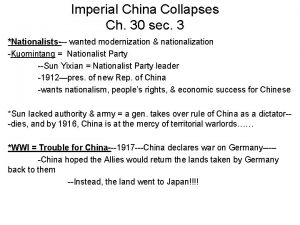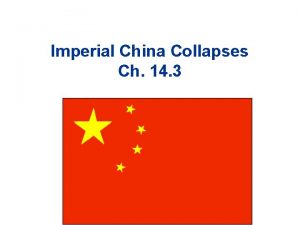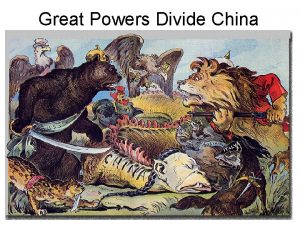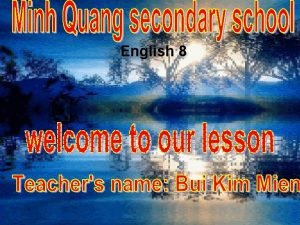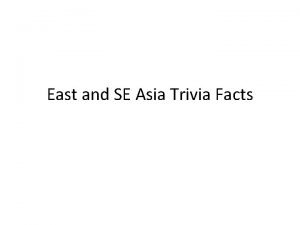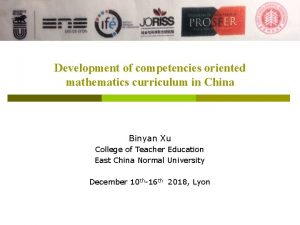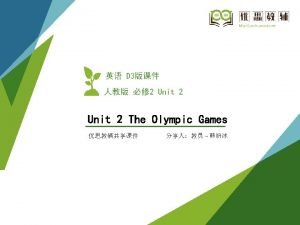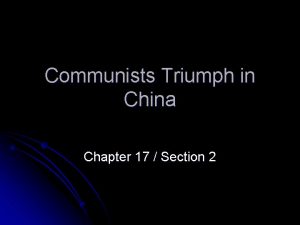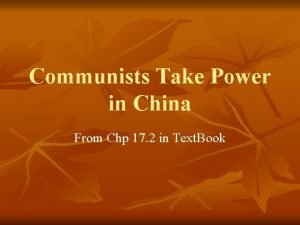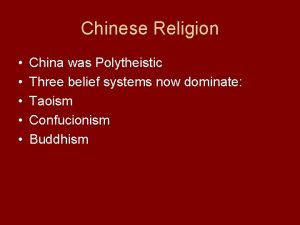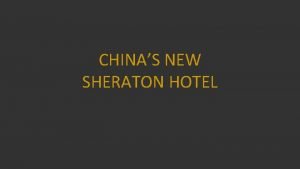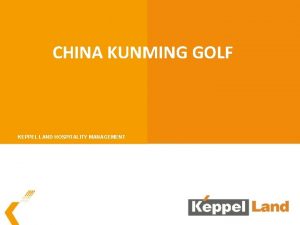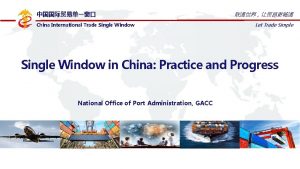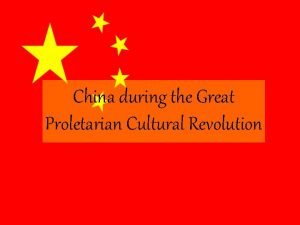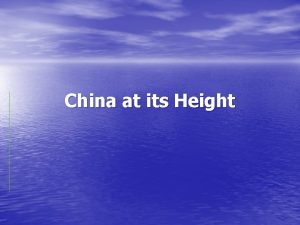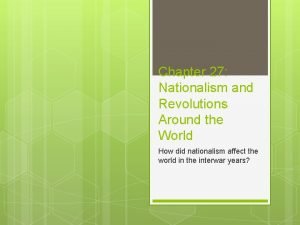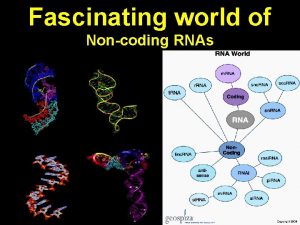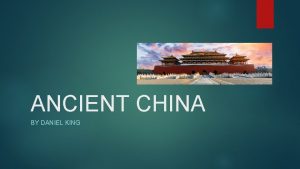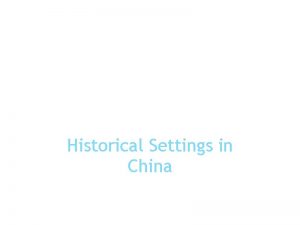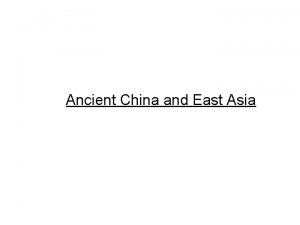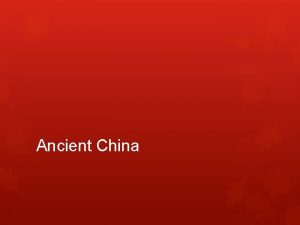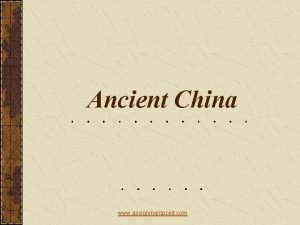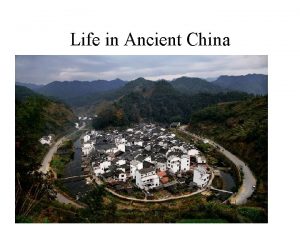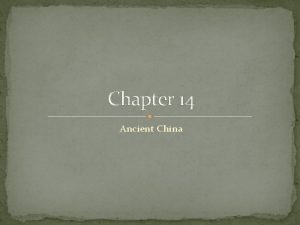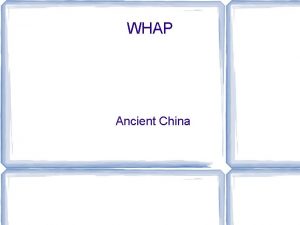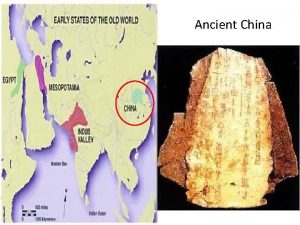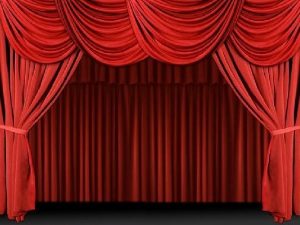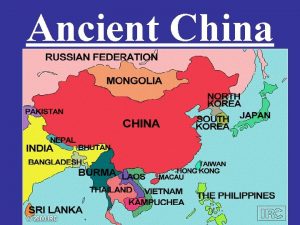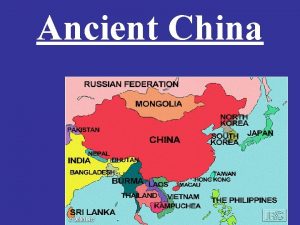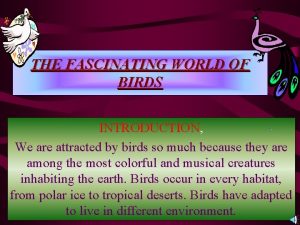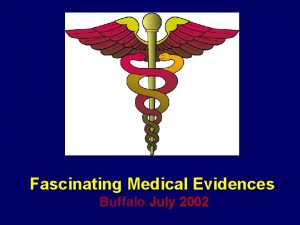Ancient China Introduction Ancient China was a fascinating































































































- Slides: 95

Ancient China

Introduction Ancient China was a fascinating mix of extreme extravagance and extreme poverty. The ancient Chinese invented paper, gunpowder, matches, umbrellas, and the compass. They created incredible art, wrote marvelous literature, and held splendid festivals.

Natural Barriers For thousands of years, the ancient Chinese thought they were pretty much alone on the planet, except for the barbarians to the north, the Mongols. China’s natural barriers to the west, south, and east helped protect these early people from invasion.

Deserts China’s natural barriers include deserts. The Gobi is one of the driest deserts in the world. In the Gobi, there is at least the hope of water, although an oasis is rare. The Taklamakan is called the “Sea of Death. ” It is the second-largest desert in the world. It offers poisonous snakes, sandstorms, boiling days, freezing nights, and intense water shortages.

Mountains China’s natural barriers include huge mountains. The Himalayas are very rugged, with ten of the tallest peaks in the world. Mount Everest is the highest mountain in the world.

Seas China’s natural barriers include three vast seas: the China Sea, the Yellow Sea, and the Pacific Ocean.

Rivers Not all of China’s geography acted as barriers. Some of its geographic features provided fertile soil and safe drinking water. China has two major river systems: the Yellow River (Huang He) and the Yangtze River.

Rivers The Yangtze (Long River) is the fourth-longest river in the world. It’s nearly 4000 miles long. It has high banks. The Huang He (Yellow River) is about 3000 miles long. It has low banks.

Rivers The ancient Chinese called all rivers in China “The Great Sorrow” because each year during the annual flood season, the towns along the rivers were destroyed. Each year, they were rebuilt. Over time, people learned the techniques of flood control. Some built their homes high above the river to avoid flooding.

Early People Civilization in ancient China began along the Yellow River about 5000 years ago. These early people harvested silk and used it to weave fine fabrics. They used a potter’s wheel to make beautiful pottery. They baked strong bricks and used them to build their homes. They worked together on flood-control and irrigation projects.

Xia Dynasty A dynasty is a line of rulers who belong to the same family and pass control from one generation to the next. Legend says that the “Great Engineer” Yu founded the first dynasty, the Xia (shee-uh) Dynasty.

Xia Dynasty Since there was no written language at that time, no one is sure if the great engineer Yu ever existed. However, scientists are sure that these early clever people did exist. Archaeologists have found ruins of their villages.

Discussion Question Why do you think these early people chose to live along the banks of a river that flooded each year and destroyed their homes?

Shang/Chou Dynasties Shang Dynasty Chou (Zhou) Dynasty 1700–c. 250 BCE Two families ruled China for the next 1500 years: first the Shang family ruled, and then the Chou family ruled. Life continued in pretty much the same way for people during both dynasties.

Shang/Chou Dynasties During the Shang and Chou dynasties, protective walls surrounded cities. Rulers, priests, and warriors lived inside the walls. Merchants and craftsmen lived outside the walls in mud houses. Farmers lived in nearby villages.

Shang/Chou Dynasties Family: The family was allimportant. If one member of a family did something wrong, the entire family was disgraced. The oldest male served as head of the family. The role of the woman was to be gentle and to obey her husband.

Shang/Chou Nobles Shang and Chou kings and nobles wore gowns of silk. They lived in large, brick homes with tiled roofs, all beautifully decorated and furnished. The air was scented with flowers from the gardens and spices from pots of food steaming on stoves. When they died, the rich were buried in lavish tombs.

Peasant Farmers Most people were farmers. Summer homes were made of bamboo branches. Winter homes were one-room mud houses with thatched roofs, dirt floors, and no furniture. Nobles owned the land. Peasants had to give nobles most of the crops they grew, along with presents of silk and wine. Peasants worked without pay on their landowner’s home, roads, and bridges.

Spring Festival It was during the annual Spring Festival that, for once, the peasants had an advantage over the nobles. At about age 15, children from several farming villages would gather. Unlike nobles, peasant marriages were rarely arranged. At the annual Spring Festival, boys and girls first met each other and chose a wife or husband.

Merchants Since merchants and craftsmen did not produce food and were not nobility, they received little respect. When a city was attacked in times of war, they were not taken inside the protective walls, but were left to fend for themselves as best they could.

Warriors During the Shang and Chou periods, there were many wars. Clan leaders were always fighting. Bronze was used as early as the Shang Dynasty to make helmets, daggers, spears, and axes.

Warriors War was waged with horsedrawn chariots. Each chariot held a driver, a spearman, and an archer. Behind them came the peasants. The peasants were foot soldiers, dressed in tunics and trousers. They wore no protective gear.

Shang Achievements The Shang made many important contributions to ancient Chinese culture. The Shang introduced the use of bronze. It was during the Shang Dynasty that chopsticks were invented.

Chinese Writing These early people also created a system of writing. zero (simple) three four one five two six

Chinese Writing seven dragon rice eight law river nine ten religion silk

Ancestor Worship The Shang introduced ancestor worship. The ancient Chinese believed that the ghosts of their dead ancestors had magical powers that could either punish or help them. To keep their ancestors happy, they brought gifts of food and wine to to temples or other special places.

Oracle Bones To communicate with their ancestors, Shang kings used “oracle bones. ” Oracle bones were the bones of animals or turtle shells. The king would ask, “Will it rain tomorrow? ” His question was carved on an oracle bone. When pricked with a hot needle, a pattern of cracks appeared in the bone.

Oracle Bones The priest (who was usually a woman) would study the cracks to find the answer to the question. Archaeologists have found over 100, 000 oracle bones. The questions they ask tell scientists a great deal about ancient Chinese daily life.

Magical Beings The ancient Chinese also believed in magical beings with magical powers, such as dragons. In ancient China, dragons did not breathe fire. They had a job to do. Their job was to guard all of China and everything in it—including the rivers, mountains, and forests. Dragons were guardians.

Religion Like most ancient civilizations, the ancient Chinese believed in many gods and goddesses. The most powerful god in ancient China was the Jade Emperor. He had many helpers. One of his helpers was the goddess of mercy, pictured as a lady in white sitting on a lotus and holding a baby. People would visit her temple and shake rattles and set off firecrackers to get her attention and ask for help.

Religion Another helper was the god of thunder. One of his jobs was to punish criminals whose crimes had gone undetected. The ancient Chinese believed greatly in reward and punishment. You can see that in their gods.

Religion In ancient China, you did not have to be born a god to become a god. If you had lived a life that was especially kind and had always helped others, the goddess Queen Mother Wang could reward you with a peach of everlasting life to eat. These good people became gods with various small jobs to do.

Religion Ordinary people who became gods by eating a magical peach were thought of as kindly, wise old men, whose job was to see that everything ran smoothly. Temples were built and festivals were held to honor the gods. All gods were very much a part of daily life.

Mandate of Heaven When the Chou overthrew the last Shang king, they had to convince the people—especially the nobles—that they had the right to rule. The Chou told people the “Mandate of Heaven” had appointed them rulers, but only as long as they were good rulers. If the Chou became selfish, heaven would appoint a new leader.

Chou Achievements Important contributions of the Chou Dynasty include the introduction of Confucianism and Taoism, which are two ancient doctrines, or ways of behaving and thinking.

Confucius was born around 551 BCE. The ruling dynasty was the Chou, but the real power lay in the hands of the local warlords. Aristocrat-scholars, called shi, traveled from one feudal state to another, offering advice on everything from politics to weddings to war. The most famous shi was Confucius.

Confucius stressed the need to develop good moral character through rules of conduct. Good moral character: Respect father/ruler, study constantly, worship reverently, and be guided by the rules of conduct. Rules of conduct: The rules actually were rules. Everything had to be done a certain way.

Confucius Here a few of his sayings: • If you make a mistake and do not correct it, this is called a mistake • When people are educated, the distinction between classes disappears • When the ruler behaves himself correctly, the people will also

Taoism began in BCE times, around the same time as Confucianism. These two doctrines were quite different. Confucianism was a set of rigid rules of social behavior. Taoism was (and is) a set of guidelines to help you become happier.

Taoism To be truly happy, Taoists believe it’s important to understand the way things are. This does not mean that there are not things we need to change about ourselves, but it’s important to recognize and trust our own inner nature and to discover who we are.

Taoism In ancient China, both Confucianism and Taoism were important parts of daily life. People followed the teachings of both doctrines every day. Confucianism provided the rules of honorable social behavior, and Taoism provided guidelines you could follow to find your way to personal happiness.

Achievements Recap Important contributions of the Shang Dynasty included the use of bronze, a system of writing, ancestor worship, oracle bones, and the invention of chopsticks. Important contributions of the Chou Dynasty included the introductions of Confucianism and Taoism.

Questions 1. What purpose was served by oracle bones? 2. Where did most peasants meet their future husband or wife? 3. What metal was important to nobles? 4. Who owned all of the land?

Qin Dynasty Qin (Ch’in) Dynasty Emperor: First Emperor Qin 221– 206 BCE Although he ruled for only 15 years, First Emperor Qin accomplished great things. He ruled with absolute control and by extreme punishment.

Terra Cotta Soldiers Can you imagine digging in your backyard one day and discovering a life-size terra cotta soldier—made 2000 years ago completely out of clay? That’s what happened in China in 1974. By the time archaeologists had finished digging, they had uncovered over 6000 life-size terra cotta soldiers.

Emperor Qin It took 720, 000 laborers about 34 years to create this incredible grouping. They finished just in time, right around 210 BCE, when First Emperor Qin died. His son, the second Qin emperor, saw to his burial.

Emperor Qin was the first man to control all of China. He did not want to be called a king. He called himself First Emperor Qin only ruled for 15 years. But, in the short time he ruled China, he accomplished an amazing amount of change.

Legalism First Emperor Qin was a legalist. Legalists believe that people are basically bad. They believe in regulating people’s lives so that people develop the discipline to work hard in the fields and in battle. • Legalists believe in strict laws • Legalists believe in harsh punishment • Legalists believe in firm management

Qin Dynasty First Emperor Qin was a legalist who ran his dynasty with absolute control and harsh punishment. It was illegal to complain about Qin’s government. If you simply said that things could improve, you could be put to death. First Emperor Qin set about organizing the lives of his people.

Bureaucracy Management: First Emperor Qin divided the empire into 36 provinces. He divided each of the provinces into districts. He put two officials in charge of each of the 36 provinces: a governor and a defender. Part of their job was to put strong people in charge in each district.

Bureaucracy: Workers were trained and paid and reported to supervisors. People at each level supervised those below them. Protection: Qin set up a system of spies. He urged people to spy on each other at work and at home in their village or neighborhood. If people turned in lawbreakers, they were rewarded; if they did not, they were executed. It was a simple system, and it worked very well.

Bureaucracy This organizational system gave him great power. That power allowed him to make great changes. Qin knew that to unify China there had to be big changes. Most of his laws had something to do with protection.

The Great Wall The Chou (Zhou) built pieces of a wall here and there to protect parts of their dynasty. Qin wanted a much better wall to protect his people. He used peasants, captured enemies, criminals, scholars, and anyone else who irritated him, and put them all to work building the Great Wall. Laborers were not paid for their work—it was slave labor.

The Great Wall is truly big. Different parts of the wall are from 15 to 50 feet high. The base has a width of between 15 and 30 feet.

The Great Wall The wall has guard towers spread along its entire length. It is made of granite, other rock, and earth. Its purpose was to keep out the Mongol invaders from the north.

The Great Wall About 300, 000 people worked on the wall during the Qin Dynasty. Rocks fell on people. Walls caved in. People died of exhaustion and disease. Laborers were fed just enough food to keep them alive. A Chinese saying goes, “Each stone in the wall represents a life lost in the wall’s construction. ”

Qin’s Changes Land ownership: First Emperor Qin took land away from thousands of nobles. He did not want noble families rising up against him. During the Qin dynasty, anyone could own land, as long as they paid the land tax. Anyone who argued with Qin was either buried alive or put to work building the Great Wall.

Qin’s Changes Standardization: He introduced one system of weights and measures, money, written language, and laws. Nobody argued with him. Law enforcement: Qin announced a new law code that applied to everyone and introduced a system for enforcing the laws.

Qin’s Changes Peasants: The peasants were given two jobs: farming and weaving (making silk). Those who tried to make money from other crafts or trade would be arrested, forced into slavery, and sent to work on the wall. If people were lazy, they were made into slaves or sent to work on the wall. In Qin’s dynasty, you did your assigned job and did it well, or you would be put to work doing something unpleasant, like being a slave or working on the wall.

Qin’s Changes Education and book burning: Censorship is control of what people read, write, hear, and see. Qin practiced total censorship. He persecuted scholars and destroyed “useless” books. Qin defined as useless any book not about medicine, agriculture, or prophecy. Useless books were burned. Over 400 scholars who refused to turn in their books were buried alive or sent to work on the wall.

Qin’s Changes Qin did not think his rule was cruel. He said, “A thousand may die so that a million may live. ” He built roads, canals, and bridges. His public-works projects probably saved millions of lives that would have been lost to floods and famine. Although many people died building the Great Wall, it did provide an advantage in war.

Qin Questions 1. What is censorship? 2. What is standardization? 3. What is bureaucracy? 4. How did Qin’s actions show that he was a legalist?

Han Dynasty Daily Life in Han Times: The Classical Age About 200 BCE to 200 CE Life was good for many of the people because of the demand for Chinese silk and the creation of the Silk Road, a major system of trade routes.

The Silk Road was not a paved road. It was not a single route. The Silk Road was a name given to any route that led across China to Rome. It was a 4000 -mile trip from China to Rome. Each had something the other wanted: Rome had gold, silver, and precious gems. China had silk, spices, and ivory.

The Silk Road It was incredibly dangerous to travel along the Silk Road. The environment was perilous. Travelers faced desolate deserts, forbidding mountains, brutal winds, and poisonous snakes. Besides those, there were bandits and pirates. There was one nice section, the Gansu Corridor, a fertile strip. To reach it, you had to cross either the desert or the mountains.

The Silk Road Few traders made the whole trip. They worked in relays. Each trader would go a certain distance, exchange their goods for other goods, and hope to return. Over the centuries, the Silk Road developed a culture of its own. The routes became lined with huge temples and booming cities. Even then, it was never easy to travel.

The Silk Road Traders along the Silk Road traveled to every corner of the Han empire. People bonded together into one civilization. They had a common culture. Even in remote sections, district officials copied the ways of the imperial court. Peasants built homes and plowed their fields in the same way all over China.

Buddhism More than goods were transported along these international trade routes. Ideas also traveled along the Silk Road, ideas that affected everyone. One of those ideas was a new religion called Buddhism spread into China as ideas and stories told by travelers along the Silk Road.

Goal of Buddhism The goal of Buddhism is to achieve “enlightenment, ” or a state of full consciousness. Buddhism teaches that you can attain it by following a way of life called the Eightfold Path.

Han Tombs The writings of the time tell us very little about Han daily life. Their tombs, however, tell us quite a lot. The Han buried clay models of their homes and belongings in their tombs. Models included details like little clay furniture and miniature bronze oil lamps.

Arts & Sciences Craftsmen made jewelry and carvings, gold ornaments and belt hooks, and delicate paintings with wire-thin brush strokes. Iron was used for making plows. Glazed pottery was brightly painted with lively hunting scenes, mountains, trees, clouds, dragons, tigers, and bears. Medicine was advanced. Paper was invented. Scroll painting began.

Public School One of the Han emperors (Emperor Wudi) agreed with Confucius that education was the key to good government. He started a system of public schools for boys only, taught by Confucian teachers. He set up schools in each province. Enrollment at the Grand School in the capital was over 30, 000 students. Students learned many things, including the teachings of Confucius.

Life in the Cities were laid out with main streets and alleyways. A strong wall made of earth and stone surrounded each city. Han cities were centers of government, education, and trade. Most marketplaces had free entertainment. Musicians played bells, drums, and string instruments, and jugglers and acrobats performed.

Cities: The Poor The poor lived in houses packed together. They had very little food, and little to no sanitation. Teens sometimes joined street gangs. Members wore distinctive clothes and armor that identified their gang. Teen gangs roamed the cities terrorizing people.

Cities: The Rich The rich imitated the style of the imperial palace. They built big houses furnished with draperies, carved furniture, and cashmere carpets. They wore belted robes with long silk-lined sleeves and warm fur coats in the winter. Children of the nobles had tutors. They studied science, math, literature, art, religion, and music.

Life in the Country The vast majority of people in Han times were farmers who lived in the country. Their mud homes were one or two stories high, with tiled or thatched roofs and curtains on the windows. Barns and other buildings surrounded each house. Several families lived in one house and worked their fields together.

Cooperatives In Han times, farmers still did not own their farms, but farms were larger in size because families had learned to team up. Together, they were able to produce more food than they needed, which allowed them to trade extra food for other items.

Peasant Life Peasants went to bed at dusk and got up at dawn. They dressed in simple clothes made of scratchy dark cloth. They stuffed their clothes with paper and cloth to stay warm in the winter. They ate rice, steamed dumplings, and fish flavored with garlic and onions. In the north, peasants ate wheat instead of rice. Compared to the Qin Dynasty, life was vastly improved.

Han Questions 1. How did archaeologists and scientists learn most of what they know about the Han Dynasty? 2. Why was education so important to the Han?

T’ang Dynasty c. 600– 900 CE The Golden Age of China By 600 CE, in early medieval times, China had become the wonder of the world. It was a time of prosperity, gaiety, and experimentation. People tried new things, like bananas!

Growth of Buddhism In T’ang times, people thought of Buddhism as a path that they could follow to enlightenment. Today, Buddhism is a major world religion. There are over 330 million Buddhists in the world.

Government Jobs Examination day: You did not have to be a noble to hold a high position. To be assigned a job in high office in one of the many towns and villages, you had to pass the government exams. It was a route to riches and fame. On examination day—the day the tests were given—cities were thronged with horses and coaches.

The Arts/Tea The arts: The T’ang empire is famous for brilliant stories, art, literature, music, and dance. Talented dancers and singers came from India and Korea to study. Tea drinking and tea ceremonies became all the rage.

T’ang Houses in the large capital city of Ch’ang-an had baths, heaters, mechanical fans, fountains, icecooled rooms, mirrors, musical instruments (such as the harp), ceramics, spoons, and goblets of gold and silver. Servants and slaves waited on the rich. The pagoda look became popular during T’ang times.

Clothing/Styles Clothing, hair, and cosmetics: Men had topknots. Women wore hats, some with little bells dangling from the edges. Women also used makeup. Eyebrows were carefully sculpted—in T’ang times, they were shaped like little mountains, like this “^”. Nobles wore fancy hats and silk robes with jade belts.

Games/Sports They played board games such as backgammon, and a game called “Go” (which is now the most popular game in Japan). Music, dancing, and archery were all popular. They played a version of football and enjoyed polo, which had been introduced from India.

Family The days of human sacrifice were long over, but honoring one’s ancestors was still very important. Family members were expected to help and care for each other. When a girl married, she went to live with her husband’s family.

School Only boys could go to school. They did not have to go to school, but it was free and encouraged. Girls learned at home. Education was so important that teachers were one of the five objects of worship (the other four were heaven, earth, the emperor, and parents).

Three Teachings In T’ang times, Confucianism, Taoism, and Buddhism became known as the “Three Doctrines, ” or the “Three Teachings. ” In T’ang times, a man might honor his ancestors by following the rigid rules of social behavior as dictated by Confucianism, attend a Buddhist pageant, and practice Taoist breathing exercises, all in the same day. These three doctrines were an important part of daily life.

Land Ownership The T’ang distributed land equally to create a nation of free farmers. Each farmer received about 15 acres. Farmers ate beans, turnips, barley cakes, melons, peaches, pork and chicken, plums, lots of fish, and drank wine. In the south they ate rice and in the north, products made from wheat.

Nomads The Western T’ang empire was peopled with nomads. Nomads did not grow food, but moved from place to place, tending herds of horses, goats and sheep. Their homes were huts built on wagons, so they could move easily. Clothing was made of wool or animal skins. Nomads ate milk and meat. They were traders, sometimes along the Silk Road.

T’ang Questions 1. How could you become rich during T’ang times? 2. Why is this period in ancient Chinese history called the “Golden Age of China”?

Inventions The ancient Chinese invented many things we use today. They invented paper, silk, matches, the wheelbarrow, gunpowder, the decimal system, the waterwheel, porcelain, lacquer, the pottery wheel, fireworks, paper money, the compass, the seismograph, tangrams, medicines, dominoes, jump rope, kites, the tea ceremony, the folding umbrella, ink, the animal harness, playing cards, printing, the abacus, wallpaper, and the crossbow.

Conclusion The ancient Chinese were very clever people. Their culture was complex and made many lasting contributions to the world. Although outsiders call this land China, after the Ch’in (Qin) empire, the Chinese today call themselves the people of Han.

Quiz 1. If you had to live in ancient China, besides being a king or a noble, what job would you like to have? Briefly explain why. 2. Name one dynasty in which you would not like to live and briefly explain why.
 Polyembyony
Polyembyony It's really fascinating
It's really fascinating It's really fascinating
It's really fascinating Ancient india vs ancient china
Ancient india vs ancient china Ancient china han
Ancient china han Ancient china social pyramid
Ancient china social pyramid Maurya accomplishments
Maurya accomplishments Taklamakan desert map
Taklamakan desert map Why is filial piety important
Why is filial piety important Ancient china map
Ancient china map Ancient china confucius
Ancient china confucius Environment of ancient china
Environment of ancient china Ancient china social class
Ancient china social class Physical map of ancient china
Physical map of ancient china Shang achievements
Shang achievements Legalism ancient china
Legalism ancient china Zhou dynasty achievements
Zhou dynasty achievements Lesson 1 schools of thought in ancient china
Lesson 1 schools of thought in ancient china Ancient china people
Ancient china people Ancient china zhou dynasty
Ancient china zhou dynasty What was the impact of daoism in ancient china
What was the impact of daoism in ancient china Physical education during renaissance
Physical education during renaissance Family life in ancient china
Family life in ancient china What is believed to be the 1 stdynasty of ancient china?
What is believed to be the 1 stdynasty of ancient china? Himalayan mountains ancient china
Himalayan mountains ancient china How did the zhou dynasty fall
How did the zhou dynasty fall Engineering an empire ancient china answer key
Engineering an empire ancient china answer key How long ago was ancient china
How long ago was ancient china Chapter 6 section 2
Chapter 6 section 2 Ancient china craftsmen
Ancient china craftsmen Ancient china achievements
Ancient china achievements Achievements of ancient china
Achievements of ancient china Map of china's natural barriers
Map of china's natural barriers China's geography
China's geography Grapes of ancient china
Grapes of ancient china Confucius idea
Confucius idea Ancient china complex institutions
Ancient china complex institutions 1750 bc ancient china
1750 bc ancient china Ancient china weapons
Ancient china weapons Ancient china barriers
Ancient china barriers 4 river valley civilizations
4 river valley civilizations Ancient means of communication pictures
Ancient means of communication pictures Body paragraph
Body paragraph Where is china
Where is china There once was a woman
There once was a woman What hemisphere is china in
What hemisphere is china in China travel brochure
China travel brochure Christenen in china
Christenen in china China großlandschaften karte
China großlandschaften karte China warring states period
China warring states period Traditional sports in china
Traditional sports in china Bevolkingsspreiding china
Bevolkingsspreiding china Tianjin pipe corporation
Tianjin pipe corporation China qin dynasty map
China qin dynasty map How many people died from the great wall of china
How many people died from the great wall of china Chinese communist revolution ap world history
Chinese communist revolution ap world history Shunjun china
Shunjun china Chartch
Chartch China arable land
China arable land Great wall of china golden ratio
Great wall of china golden ratio China political system
China political system Physiographic map of china
Physiographic map of china Physiographic map of china
Physiographic map of china China physical landforms
China physical landforms Do tigers eat pandas
Do tigers eat pandas When did mao take over china
When did mao take over china Poverty causes
Poverty causes Criofobia
Criofobia Master kong drinks
Master kong drinks Sistema de numeración china antigua
Sistema de numeración china antigua Organización política de china
Organización política de china Tiaa china
Tiaa china Cowell e holdings
Cowell e holdings Scramble for africa webquest
Scramble for africa webquest Chapter 30 section 3 imperial china collapses
Chapter 30 section 3 imperial china collapses Chapter 14 section 3 imperial china collapses
Chapter 14 section 3 imperial china collapses Chinese dragon political cartoon
Chinese dragon political cartoon Gran teatro nacional de china
Gran teatro nacional de china Past participle travel
Past participle travel Xxxxx sexy.com
Xxxxx sexy.com Xi jiang river
Xi jiang river China math curriculum
China math curriculum Interview china
Interview china Comparative development experiences of india and china
Comparative development experiences of india and china Chapter 17 section 2 communists triumph in china
Chapter 17 section 2 communists triumph in china Chapter 17 section 2 communists take power in china
Chapter 17 section 2 communists take power in china Cet4 sample test
Cet4 sample test Was china polytheistic
Was china polytheistic Sheraton hotels china huzhou
Sheraton hotels china huzhou Innofund
Innofund Kunming golf package
Kunming golf package Chinese single window
Chinese single window Bourgeoisie china
Bourgeoisie china China at its height
China at its height China aerodynamics research and development center
China aerodynamics research and development center When did mao take over china
When did mao take over china
